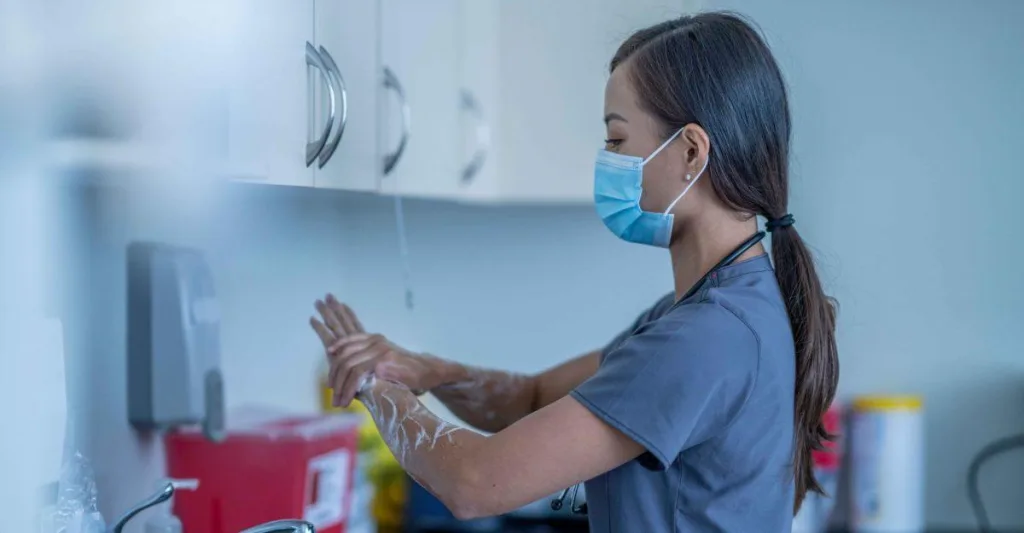Before the pandemic, lessons about infection control in nursing were somewhat predictable.
"Prior to COVID-19, what everyone learned -- whether it was an orientation or in the annual competencies -- was...pretty set in stone," said Marie Moss, RN, MPH, BSN, CIC, CPHQ, FAPIC, Director of the Department of Infection Prevention and Control at Mount Sinai Beth Israel Hospital in New York City. "Healthcare workers believed that they had a good understanding of hospital infection prevention policies."
The pandemic erased that complacency and enhanced education for nurses and infection control in unique ways. The renewed focus on how infection control in nursing is presented to healthcare professionals is among the major lessons learned since 2020.
"They needed to understand the why," said Marie Wilson, RN, MSN, CIC, Chairperson of the Communications Committee for the Association for Professionals in Infection Control and Epidemiology and an infection preventionist in Seattle, Washington. "That's a big change over the past three years."
"Nurses have always been able to connect the dots of infection prevention to protecting their patients, but now they're really connecting the dots on protecting myself, my family," she said. "If there's any good that has come out of the pandemic, it's the nursing workforce having a much more concrete understanding of why the infection prevention principles are the way they are."
Change by the day
As the pandemic evolved, infection prevention nurses were challenged by change at a moment's notice when care recommendations often shifted regularly.
For Moss and her team, communicating frequent changes related to infection control required a more intentional approach.
"We had to put it forth in such a way that they could understand the rationale behind it," she said. "Whatever there was as a recommendation, we had to be the conduit, explaining the background of why we're saying, 'Do this,' then tomorrow why we're saying, 'Do that.'"
Communicating with professionals in various healthcare roles -- such as personal care assistants, patient care technicians, and certified nursing assistants -- was a necessity to ensure the latest information was available to anyone caring for patients.
"That's one of the big shifts I've seen -- more intentional, broad education audiences, which is wonderful," Wilson said of topics such as hand hygiene, properly putting on and removing personal protective equipment (PPE), and understanding what PPE is needed and when it should be used.
Nursing infection control education had to be delivered to ensure all audiences connected with the information.
"If we're going to speak to a mixed audience, then we need to make sure that everyone in the audience understands, has time to ask questions, and has time to get their concerns met," Moss said.
Post-COVID-19 focus
No matter the setting, COVID-19 had an impact on hundreds of thousands of patients and healthcare professionals. Perhaps one of the most impacted was nursing homes and long-term care facilities. According to 2023 data from the Centers for Medicare & Medicaid Services website, more than 1.5 million COVID-19 cases have been recorded in those settings, along with 164,285 deaths.
Settings outside the hospital, such as home health and skilled nursing facilities, are of particular concern still today.
"When you think back to the term everyone was saying - 'flatten the curve' - how do you do that?" Wilson asked. "You go more upstream. You prevent the infections before they need hospitalized care. That's really where public health nursing and infection prevention intersect."
Understanding where patients have been before they arrive at the hospital is a necessity.
"We have to truly look at the continuum of care," Moss said. "In infection prevention, the continuum of care is not relegated to a hospital, not relegated to a clinic, not relegated to an emergency room, not solely in the ORs. It is in our patient homes, nursing homes, some acute rehab centers, hospices. A patient would go from one point of care to another, and everybody is affected."
Whatever organism a patient brings to a hospital, knowing their steps along the way can be beneficial for infection control. "Because we don't know where things start and end, we have to address every place a patient may be and make sure that we are applying the rules to everybody," Moss said.
A welcoming specialty
When Moss talks about infection control nursing, she doesn't always feel as though others understand her passion.
"Before COVID, when I talked about the kind of work I did in infection prevention, I felt like most people thought infection prevention wasn't the most exciting area of healthcare," she said. "It's hard to verbalize everything we do. It's the field that's most exciting to me. It's always challenging. There's always something new going on."
As COVID-19 put a spotlight on nurses and infection control, nursing schools saw an impact on applications. The American Association of Colleges of Nursing released data that showed enrollment in entry-level baccalaureate programs rose 3.3% during 2021.
This came at a time when the pandemic could have caused students to be discouraged about careers in nursing. For current nurses who are curious about becoming an infection control nurse, Wilson's story is one that can encourage positive change.
As an ICU nurse, Wilson worked on a catheter-associated UTI prevention task force led by an infection preventionist who sparked her interest in the specialty.
"I didn't even know what the department was when a colleague suggested that I consider transitioning," she said. "I love the autonomy that I get from infection prevention."
Infection control in nursing offers an opportunity, according to Wilson, to learn and grow, while impacting nurses, patients, and other healthcare colleagues. "If there are nurses out there that are frustrated because of their experience through the pandemic, come be with us," she said.
"Be part of the solution because we want you. Maybe you don't become an infection preventionist but become a liaison between your department and the infection prevention department. They want to have those connections with you."
Challenges ahead
Before the COVID-19 pandemic began, Wilson said she told her colleagues that a specific bug may not be the next big issue facing infection control for nurses. Instead, she mentioned, "lack of availability to a key supply. I was thinking at the time of something related to a pharmacy - sterile syringes or what have you."
Little did she know both a global bug, a shortage of masks, and other resources would be major factors at the height of the pandemic. Wilson admits that supply chain concerns "still keep me up at night." She also knows that unique challenges lie ahead.
"A big thing is that as urbanization continues and as we continue to have more interactions with rare and intricate species of birds and [other] animals, different viruses and bacteria are certainly something that we're going to face," Wilson said.
"What's on the top of my mind is early detection of these new infections, and thus being able to control the spread."
The impact of global warming in the years ahead is another concern for nurses and infection control.
"It leads to microorganism spread because of temperature changes and humidity," Moss said.
More extreme climate events, such as floods and mudslides, according to Moss, could lead to interruptions at various medical manufacturing facilities around the world, such as in Puerto Rico, home to more than 20 different such companies.
The post-COVID-19 lessons will continue to arise for nurses and infection control, which will provide opportunities to learn, react, and save lives. "We're not done," Wilson said. "We're only getting started."
Explore continuing education courses related to infection prevention and other important topics in Nurse.com's course catalog. 






